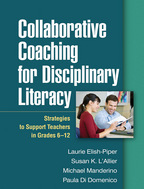Collaborative Coaching for Disciplinary Literacy
Strategies to Support Teachers in Grades 6-12
Laurie Elish-Piper, Susan K. L'Allier, Michael Manderino, and Paula Di Domenico
What Is Disciplinary Literacy?
Teaching for Disciplinary Literacy
Disciplinary Literacy in Action
Disciplinary Literacy: An Integral Aspect of Today's Standards
The Complexity of Disciplinary Literacy Instruction
Why Disciplinary Literacy Matters for Secondary Literacy Coaches
II. Disciplinary Literacy Coaching
What Is Literacy Coaching?
Disciplinary Literacy Coaching and Change
Guidelines for Effective Disciplinary Literacy Coaching
Three Layers of Coaching
Coaching Stances and Coaching Language
Making the Most of Coaching Time
Summary
III. Models of Disciplinary Literacy Coaching
Teacher-Initiated Model
Co-Teaching Model
Department/Team Model
Liaison Model
Selecting a Disciplinary Literacy Coaching Model
Summary
IV. Large-Group Coaching Strategies to Build a Foundation for Disciplinary Literacy Instruction
Strategy 1: Establishing a Climate for Disciplinary Literacy Coaching
Strategy 2: Facilitating an Article Study Group
Strategy 3: Providing Professional Development Golden Nuggets at Faculty, Department, and Team Meetings
Strategy 4: Presenting Powerful Professional Development
Strategy 5: Using Technology to Connect Coaches and Teachers
V. Small-Group Coaching Strategies to Support Disciplinary Literacy Instruction
Strategy 6: Determining Disciplinary Literacy Outcomes and Creating Assessment Structures
Strategy 7: Selecting, Assessing, and Scaffolding Complex Texts
Strategy 8: Prioritizing Vocabulary for Instruction
Strategy 9: Reviewing Common Assessments
Strategy 10: Developing Discussion Protocols
Strategy 11: Facilitating Teacher Inquiry into the Disciplines
VI. Individual Coaching Strategies to Support Teachers with Disciplinary Literacy Instruction
Strategy 12: Creating Essential Questions
Strategy 13: Developing Questions with Objectives
Strategy 14: Applying the Extended Gradual Release of Responsibility Model
Strategy 15: Implementing Three Levels of Think-Aloud
Strategy 16: Adopting, Adapting, and Creating Strategies
Strategy 17: Using the Coaching Cycle
VII. Profiles of Highly Effective Disciplinary Literacy Coaches
Profile 1: Establishing and Maintaining Administrator Support
Profile 2: Applying the Layered Approach to Coaching
Profile 3: Getting into Classrooms
Profile 4: Differentiating Coaching to Support All Teachers
Profile 5: Working with Hesitant Teachers
Profile 6: Using Tools and Tips for Productive Coaching
Profile 7: Developing a Support System
Final Thoughts
References



